X-ray Computed Tomography of PGE-Rich Anorthosite from the Main Reef of the Yoko–Dovyren Layered Massif
Abstract
:1. Introduction
1.1. Short Notes on Previous CT Studies of Sulfide-Mineralized Rocks
1.2. X-ray Computed Tomography of the YDM Rocks
2. Geology, Stratigraphic Units, and the Structure of the YDM
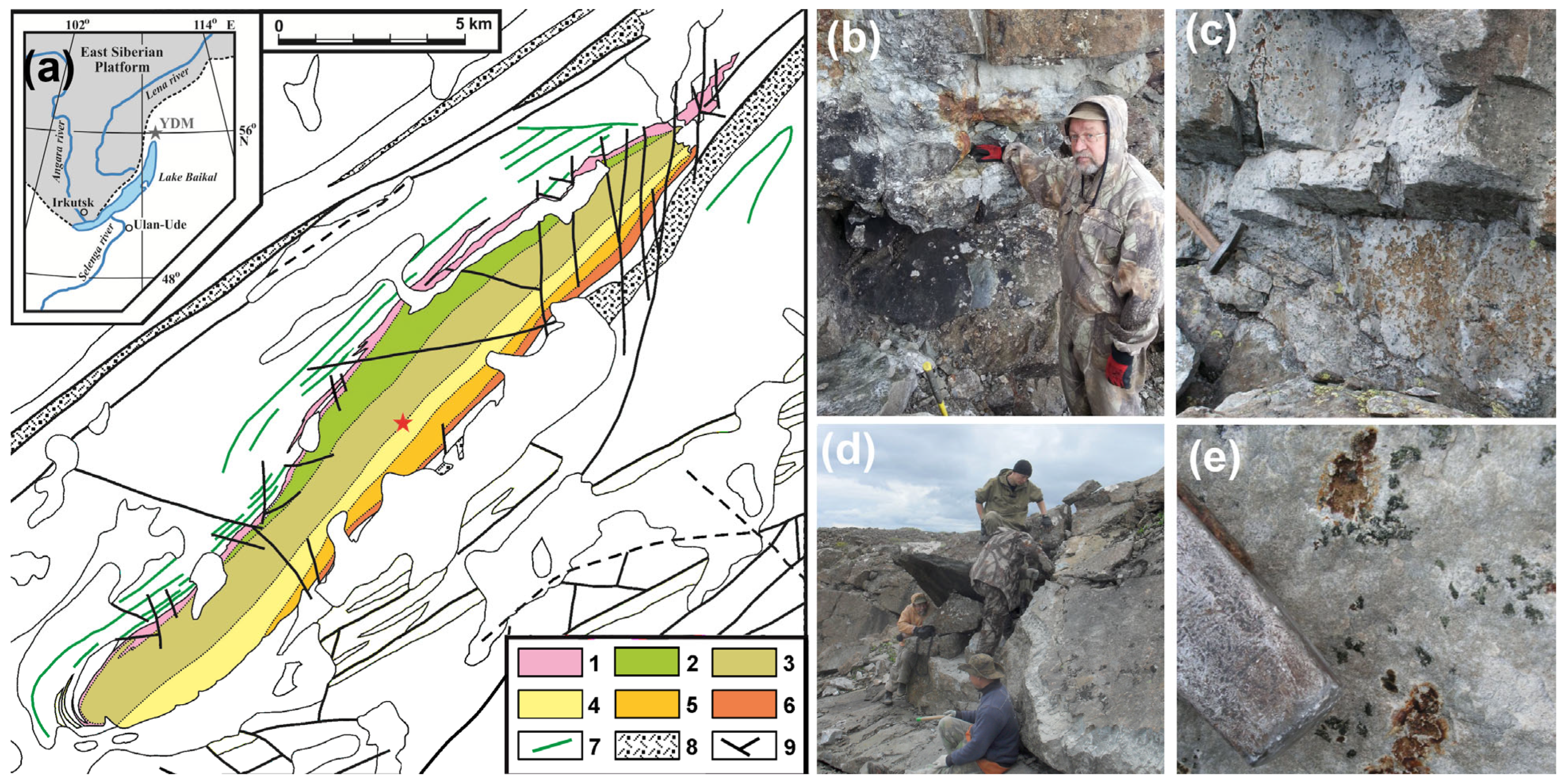
2.1. Cumulate Succession of the Dovyren Rocks
2.2. Anorthosites of the Main Reef
3. Samples and Methods
3.1. Mineralogy of the Studied Anorthosite
3.2. Microprobe Studies
3.3. Three Stages of X-ray Computed Tomography
| Sample | Pl-Dominated Silicate Matrix | Sulfides | Phase 3 (Probable “PGM”) | |
|---|---|---|---|---|
| vol.% | Content, vol.% | Connectivity, % | Content, vol.% | |
| 13DV539-9 | ||||
| 10mm-t1 | 94.39 | 5.6 | 54 | 0.01 |
| 10mm-b1 | 91.1 | 8.9 | 8 | - |
| 10mm-t2 | 95.39 | 4.6 | 41 | 0.01 |
| 10mm-b2 | 94.59 | 5.4 | 20 | 0.01 |
| 3mm-t1-1 | 99.1 | 0.9 | 12 | - |
| 3mm-t1-2 | 89.09 | 10.9 | 89 | 0.01 |
| 3mm-t2-1 | 95.69 | 4.3 | 41 | 0.01 |
| 3mm-t2-2 | 95.79 | 4.2 | 63 | 0.01 |
| 3mm-b2-1 | 95.78 | 4.2 | 7 | 0.02 |
| 3mm-b2-2 | 96.0 | 4.0 | 12 | - |
| Sample | Quantity, vol.% | Quantity, Numbers | Max. Linear Size, µm | Sphericity * |
|---|---|---|---|---|
| 13DV539-9 | ||||
| 10mm-t1 | 0.01 | 58 | 115 | 0.81 |
| 10mm-t2 | 0.01 | 41 | 124 | 0.82 |
| 10mm-b2 | 0.01 | 21 | 80 | 0.84 |
| 3mm-t1-2 | 0.01 | 143 | 108 | 0.83 |
| 3mm-t2-1 | 0.01 | 102 | 135 | 0.83 |
| 3mm-t2-2 | 0.01 | 11 | 44 | 0.77 |
| 3mm-b2-1 | 0.02 | 143 | 104 | 0.80 |
4. Results
Searching for PGE Minerals and Their Characteristics
5. Discussion
5.1. Regarding Sulfide Connectivity
5.2. Associations of Potential PGMs and Sulfides
5.3. SEM Studies of the Potential PGMs
6. Conclusions
Author Contributions
Funding
Data Availability Statement
Acknowledgments
Conflicts of Interest
References
- Baker, D.R.; Mancini, L.; Polacci, M.; Higgins, M.D.; Gualda, G.A.R.; Hill, R.J.; Rivers, M.L. An introduction to the application of X-ray microtomography to the three-dimensional study of igneous rocks. Lithos 2012, 148, 262–276. [Google Scholar] [CrossRef]
- Barnes, S.J.; Mungall, J.E.; Le Vaillant, M.; Godel, B.; Lesher, M.C.; Holwell, D.; Peter, C.; Lightfoot, P.C.; Krivolutskaya, N.; Wei, B. Sulfide–silicate textures in magmatic Ni–Cu-PGE sulfide ore deposits: Disseminated and net-textured ores. Am. Mineral. 2017, 102, 473–506. [Google Scholar] [CrossRef]
- Barnes, S.J.; Fiorentini, M.L.; Austin, P.; Gessner, K.; Hough, R.M.; Squelch, A.P. Three dimensional morphology of magmatic sulfides sheds light on ore formation and sulfide melt migration. Geology 2008, 36, 655–658. [Google Scholar] [CrossRef]
- Korost, D.V.; Ariskin, A.A.; Pshenitsyn, I.V.; Khomyak, A.N. X-Ray computed tomography as a method for reproducing 3D characteristics of sulfides and spinel disseminated in plagiodunites from the Yoko-Dovyren intrusion. Petrology 2019, 27, 370–385. [Google Scholar] [CrossRef]
- Mungall, J.E.; Su, S. Interfacial tension between magmatic sulfide and silicate liquids: Constraints on kinetics of sulfide liquation and sulfide migration through silicate rocks. Earth Planet. Sci. Lett. 2005, 234, 135–149. [Google Scholar] [CrossRef]
- Pearce, M.A.; Godel, B.M.; Fisher, L.A.; Schoneveld, L.E.; Cleverley, J.S.; Oliver, N.H.S.; Nugus, M. Microscale data to macroscale processes: A review of microcharacterization applied to mineral systems. Geol. Soc. London: Spec. Publ. 2017, 453, 7–39. [Google Scholar] [CrossRef]
- Godel, B.M.; Barnes, S.-J.; Maier, W.D. 3-D distribution of sulfide minerals in the Merensky Reef (Bushveld Complex, South Africa) and the J-M Reef (Stillwater Complex, USA) and their relationship to microstructures using X-ray computed tomography. J. Petrol. 2006, 47, 1853–1872. [Google Scholar] [CrossRef]
- Rose, L.A.; Brenan, J.M. Wetting properties of Fe–Ni–Co–Cu–O–S melts against olivine: Implications for sulfide melt mobility. Econ. Geol. 2001, 96, 145–157. [Google Scholar] [CrossRef]
- Godel, B.M.; Barnes, S.J.; Barnes, S.-J.; Maier, D. Platinum ore in three dimensions: Insights from high-resolution X-ray computed tomography. Geology 2010, 38, 1127–1130. [Google Scholar] [CrossRef]
- Godel, B.M.; Rudashevsky, N.S.; Nielsen, T.F.D.; Barnes, S.J.; Rudashevsky, V.N. New constraints on the origin of the Skaergaard intrusion Cu–Pd–Au mineralization: Insights from high-resolution X-ray computed tomography. Lithos 2014, 190, 27–36. [Google Scholar] [CrossRef]
- Holwell, D.A.; Barnes, S.J.; Le Vaillant, M.; Keays, R.R.; Fisher, L.A.; Prasser, R. 3D textural evidence for the formation of ultra-high tenor precious metal bearing sulphide microdroplets in offset reefs: An extreme example from the Platinova Reef, Skaergaard Intrusion, Greenland. Lithos 2016, 256–257, 55–74. [Google Scholar] [CrossRef]
- Robertson, J.C.; Barnes, J.S.; Le Vaillant, M.L. Dynamics of magmatic sulphide droplets during transport in silicate melts and implications for magmatic sulphide ore formation. J. Petrol. 2016, 56, 2445–2472. [Google Scholar] [CrossRef]
- Pshenitsyn, I.V.; Ariskin, A.A.; Nikolaev, G.S.; Kislov, E.V.; Korost, D.V.; Yapaskurt, V.O.; Sobolev, S.N. Morphology, Mineralogy, and Composition of Sulfide Droplets in Picrodolerite from a Near-Bottom Apophysis of the Yoko-Dovyren Layered Intrusion. Petrology 2020, 28, 246–262. [Google Scholar] [CrossRef]
- Pshenitsyn, I.V.; Ariskin, A.A.; Nikolaev, G.S.; Korost, D.V.; Yapaskurt, V.O.; Kislov, E.V.; Sobolev, S.N.; Kubrakova, I.V.; Tyutyunnik, O.A. Geochemistry and petrology of protosulfide melts in an ore-bearing apophysis of the Yoko-Dovyren intrusion. Geochem. Int. 2022, 60, 235–255. [Google Scholar] [CrossRef]
- Kislov, E.V. The Yoko-Dovyren layered massif Rus.; BNTs SD RAN: Ulan-Ude, Russia, 1998; p. 265. [Google Scholar]
- Rytsk, E.Y.; Shalaev, V.S.; Rizvanova, N.G.; Krymsky, R.; Makeev, A.F.; Rile, G.V. Olokit zone of the Baikal folded region: New isotope-geochronological and petrochemical data Rus. Geotectonics 2002, 1, 29–41. [Google Scholar]
- Konnikov, E.G. Differentiated Ultrabasic-Basic Complexes in the Precambrian Rocks of Transbaikalia; Rus. Nauka: Novosibirsk, Russia, 1986; Volume 127. [Google Scholar]
- Ariskin, A.A.; Kostitsyn, Y.A.; Konnikov, E.G.; Danyushevsky, L.V.; Meffre, S.; Nikolaev, G.S.; McNeill, A.; Kislov, E.V.; Orsoev, D.A. Geochronology of the Dovyren Intrusive Complex, Northwestern Baikal area, Russia, in the Neoproterozoic. Geochem. Int. 2013, 51, 859–875. [Google Scholar] [CrossRef]
- Orsoev, D.A. Anorthosites of the low-sulfide platiniferous horizon (Reef I) in the upper Riphean Yoko-Dovyren massif (Northern Cisbaikalia): New data on the composition, PGE–Cu–Ni mineralization, fluid regime, and formation conditions. Geol. Ore Depos. 2019, 61, 306–332. [Google Scholar] [CrossRef]
- Ariskin, A.A.; Danyushevsky, L.V.; Fiorentini, M.L.; Nikolaev, G.S.; Kislov, E.V.; Pshenitsyn, I.V.; Yapaskurt, V.O.; Sobolev, S.N. Petrology, geochemistry, and origin of sulfide-bearing and PGE- mineralized troctolites from the Konnikov zone in the Yoko-Dovyren layered intrusion. Russ. Geol. Geophys. 2020, 61, 611–633. [Google Scholar] [CrossRef]
- Ariskin, A.A.; Danyushevsky, L.V.; Nikolaev, G.S.; Kislov, E.V.; Fiorentini, M.L.; McNeill, A.; Kostitsyn, Y.A.; Goemann, K.; Feig, S.; Malyshev, A. The Dovyren intrusive complex (Southern Siberia, Russia): Insights into dynamics of an open magma chamber with implications for parental magma origin, composition, and Cu–Ni- PGE fertility. Lithos 2018, 302, 242–262. [Google Scholar] [CrossRef]
- Orsoev, D.A.; Mekhonoshin, A.S.; Kanakin, S.V.; Badmatsyrenova, R.A.; Khromova, E.A. Gabbro–peridotite sills of the Late Riphean Dovyren plutonic complex (northern Baikal region). Russ. Geol. Geophys. 2018, 59, 472–485. [Google Scholar] [CrossRef]
- Distler, V.V.; Stepin, A.G. Low-Sulfide PGE-bearing unit of the Yoko–Dovyren layered ultrabasic-basic intrusion (Northern Baikal region). Doklady Akademii Nauk 1993, 328, 498–501. (In Russian) [Google Scholar]
- Konnikov, E.G.; Meurer, W.P.; Neruchev, S.S.; Prasolov, E.M.; Kislov, E.V.; Orsoev, D.A. Fluid Regime of platinum group elements (PGE) and gold-bearing reef formation in the Dovyren mafic–ultramafic layered complex, Eastern Siberia, Russia. Miner. Depos. 2000, 35, 526–532. [Google Scholar] [CrossRef]
- Spiridonov, E.M. Review of the gold mineralogy in the main types of Au-mineralization. In Gold of the Kola Peninsula and Adjacent Regions; Voitekhovsky, Y.A., Ed.; K&M: Apatity, Russia, 2010; pp. 143–171. [Google Scholar]
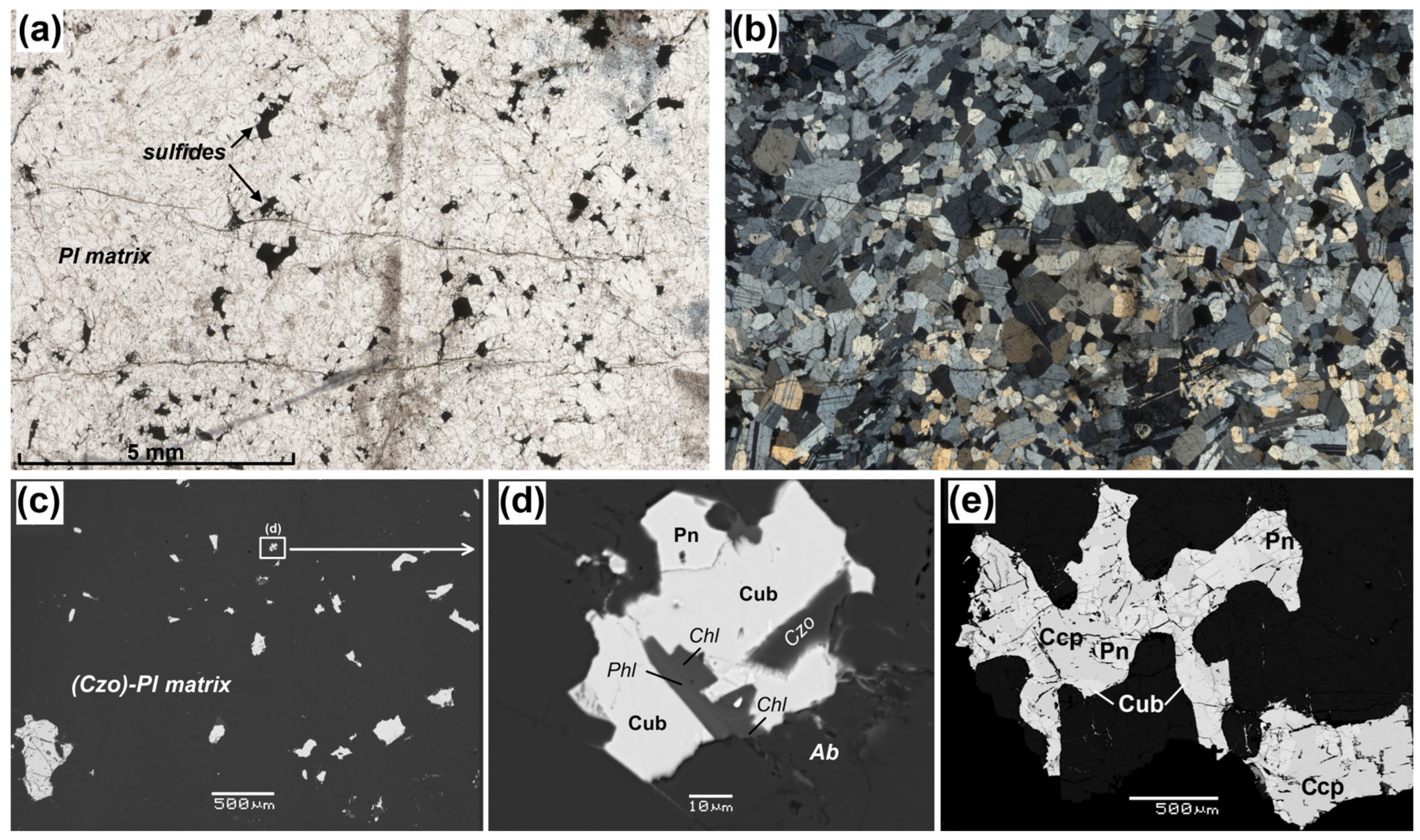
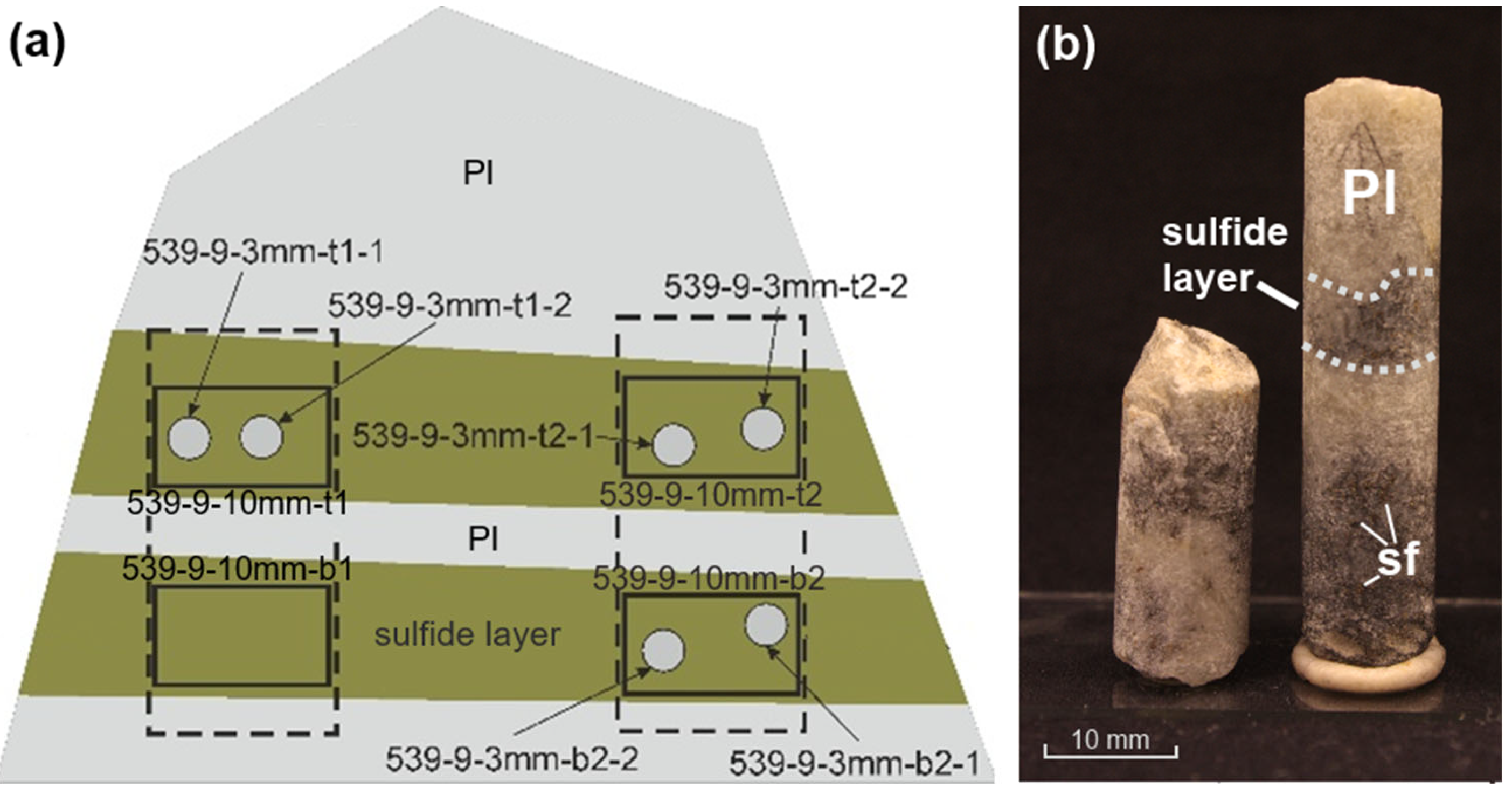
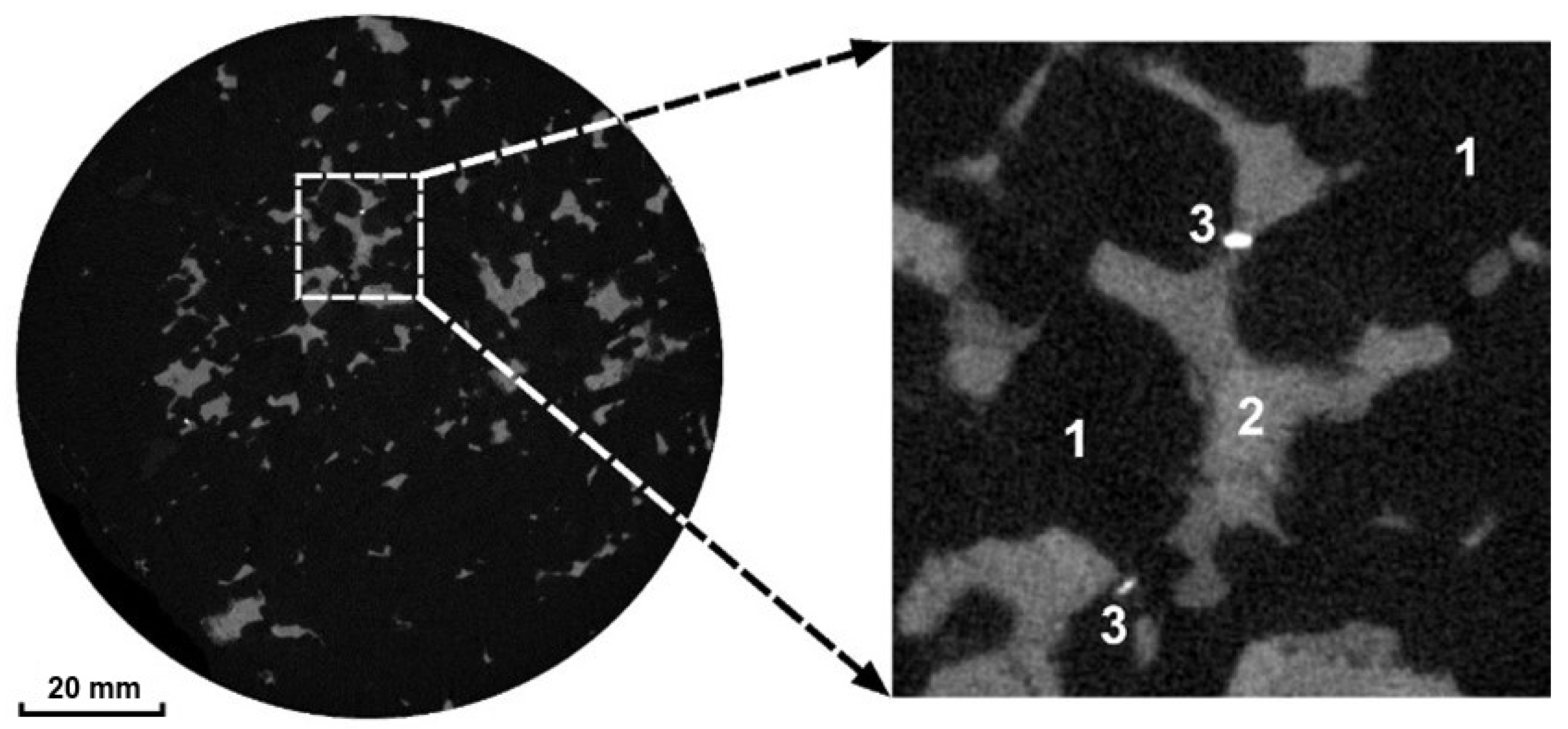
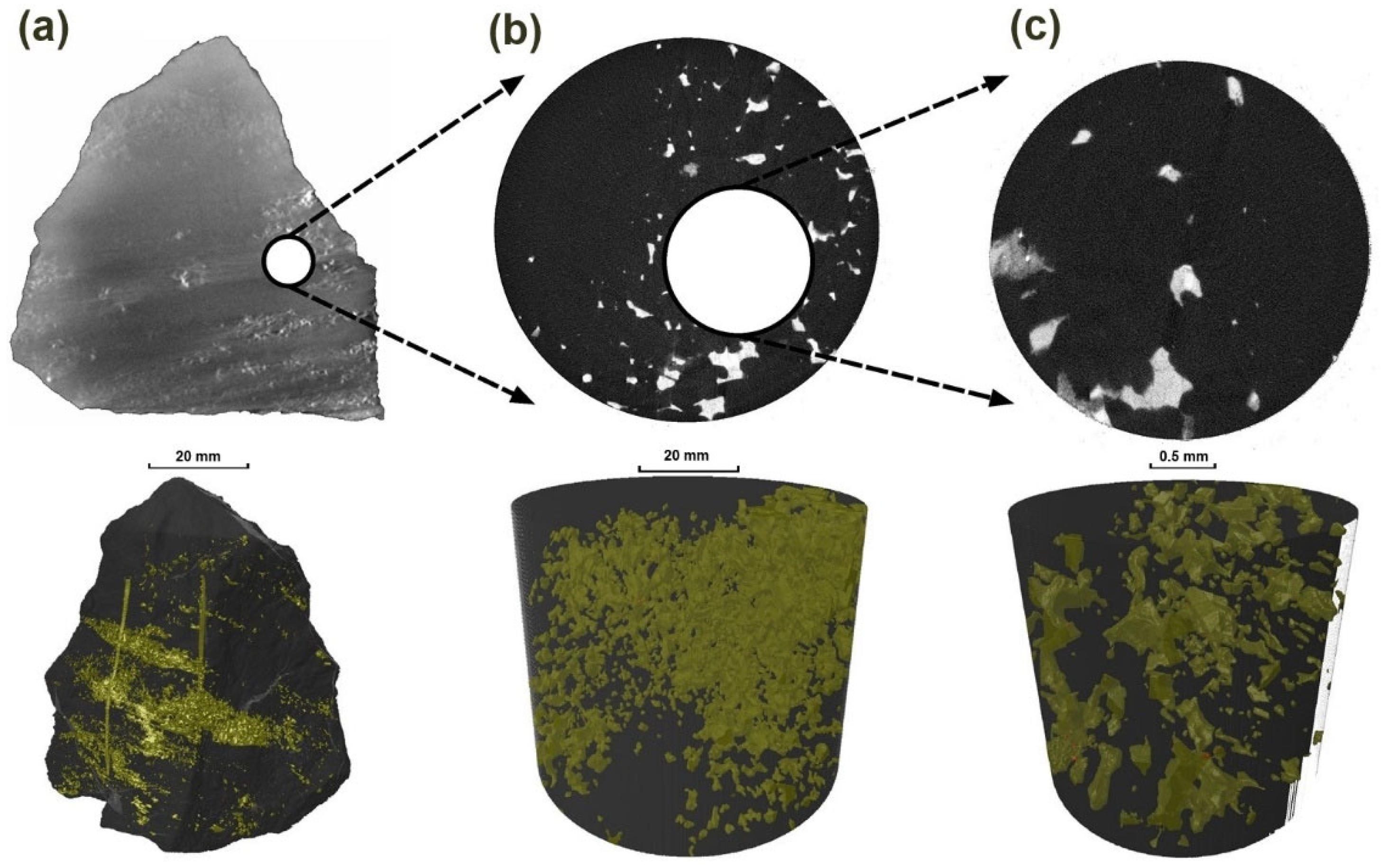



| Moncheite Points | Te, wt.% | Pt, wt.% | Pb, wt.% | Bi, wt.% | Total wt.% |
|---|---|---|---|---|---|
| 539-9-2a_32 | 50.92 | 41.02 | 1.89 | 4.45 | 98.28 |
| 539-9-2a_34 | 46.56 | 38.98 | 2.63 | 7.44 | 95.61 |
| 539-9-2a_35 | 45.17 | 39.38 | 2.86 | 9.68 | 97.09 |
| Electrum Points | Ag, wt.% | Au, wt.% | Total wt.% | ||
| 539-9-1 | 41.83 | 55.12 | 96.95 | ||
| 539-9-2 | 40.99 | 54.32 | 95.31 | ||
| 539-9-3 | 43.92 | 55.35 | 99.27 | ||
Disclaimer/Publisher’s Note: The statements, opinions and data contained in all publications are solely those of the individual author(s) and contributor(s) and not of MDPI and/or the editor(s). MDPI and/or the editor(s) disclaim responsibility for any injury to people or property resulting from any ideas, methods, instructions or products referred to in the content. |
© 2023 by the authors. Licensee MDPI, Basel, Switzerland. This article is an open access article distributed under the terms and conditions of the Creative Commons Attribution (CC BY) license (https://creativecommons.org/licenses/by/4.0/).
Share and Cite
Pshenitsyn, I.V.; Ariskin, A.A.; Korost, D.V.; Sobolev, S.N.; Yapaskurt, V.O.; Nikolaev, G.S.; Kislov, E.V. X-ray Computed Tomography of PGE-Rich Anorthosite from the Main Reef of the Yoko–Dovyren Layered Massif. Minerals 2023, 13, 1307. https://doi.org/10.3390/min13101307
Pshenitsyn IV, Ariskin AA, Korost DV, Sobolev SN, Yapaskurt VO, Nikolaev GS, Kislov EV. X-ray Computed Tomography of PGE-Rich Anorthosite from the Main Reef of the Yoko–Dovyren Layered Massif. Minerals. 2023; 13(10):1307. https://doi.org/10.3390/min13101307
Chicago/Turabian StylePshenitsyn, Ivan V., Alexey A. Ariskin, Dmitry V. Korost, Sergei N. Sobolev, Vasily O. Yapaskurt, Georgy S. Nikolaev, and Evgeny V. Kislov. 2023. "X-ray Computed Tomography of PGE-Rich Anorthosite from the Main Reef of the Yoko–Dovyren Layered Massif" Minerals 13, no. 10: 1307. https://doi.org/10.3390/min13101307
APA StylePshenitsyn, I. V., Ariskin, A. A., Korost, D. V., Sobolev, S. N., Yapaskurt, V. O., Nikolaev, G. S., & Kislov, E. V. (2023). X-ray Computed Tomography of PGE-Rich Anorthosite from the Main Reef of the Yoko–Dovyren Layered Massif. Minerals, 13(10), 1307. https://doi.org/10.3390/min13101307







